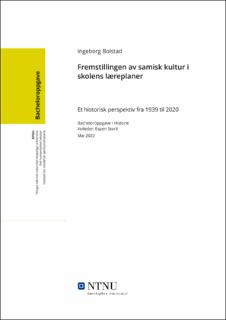| dc.contributor.advisor | Storli, Espen | |
| dc.contributor.author | Bolstad, Ingeborg | |
| dc.date.accessioned | 2022-09-20T17:20:09Z | |
| dc.date.available | 2022-09-20T17:20:09Z | |
| dc.date.issued | 2022 | |
| dc.identifier | no.ntnu:inspera:109090104:46964574 | |
| dc.identifier.uri | https://hdl.handle.net/11250/3019878 | |
| dc.description.abstract | Bakgrunnen for denne studien var mangel på forskning som sammenligner læreplaner og lærebøker sin omtale av samisk kultur og historie. Oppgaven belyser hvilken plass den samiske kulturen har i læreplaner. Den undersøker generell del og fagplanene for samfunnsfag på grunnskolenivå i hver læreplan, fra Normalplanen fra 1939 til Fagfornyelsen fra 2020. I tillegg ser den på lærebøker for de læreplaner og sammenligner. Her vil fokusområdet være hvor mye det står om samisk kultur og historie i de ulike lærebøkene til de forskjellige læreplanene. Oppgaven undersøker problemstillingen: I hvilken grad blir samisk kultur og historie omtalt i norske læreplaner og gjenspeiles kravene i læreplanen i norske lærebøker? I oppgaven er det gjort en kvalitativ analyse av læreplanene. Det er både gjort en kvantitativ og kvalitativ analyse av de utvalgte lærebøkene. Ved alle analysene er det utarbeidet forskningsspørsmål som har bidratt til å spisse undersøkelsen. Studien viser at det er stor variasjon i hvor mye samisk kultur omtales i de ulike læreplanene. Det skyldes flere faktorer, blant annet hvordan læreplanene er bygget opp, hvilken posisjon samene hadde i samfunnet og hvilke pedagogiske og politiske tendenser som var gjeldende ved hver plan. I tillegg er variasjonen stor i hvilket fokus de ulike lærebøkene gir det samiske. Ved to av tre læreplaner gjenspeiler ikke lærebøkene de kravene som fagplanene stiller på grunn av for lite lærestoff. Lærebøkene møter kravene som blir stilt ved en læreplan med mye lærestoff om samisk kultur og historie. | |
| dc.description.abstract | The background for this study was the lack of research that compares curricula and textbooks' coverage of Sami culture and history. The thesis sheds light on the place of Sami culture in curricula. It examines the general part and the curricula for social studies at primary school level in each curriculum, from the Normal curriculum from 1939 to the subject renewal from 2020. In addition, it looks at textbooks for the curricula and compares. Here, the focus area will be how much is said about Sami culture and history in the various textbooks for the various curricula. The thesis examines the problem: To what extent is Sami culture and history discussed in Norwegian curricula and are the requirements in the curriculum reflected in Norwegian textbooks? In the thesis, a qualitative analysis of the curricula has been made. A quantitative and qualitative analysis of the selected textbooks has been carried out. In all the analyzes, research questions have been prepared that have helped to sharpen the survey. The study shows that there is great variation in how much Sami culture is mentioned in the various curricula. This is due to several factors, including how the curricula are structured, what position the Sami had in society and what pedagogical and political tendencies were applicable to each plan. In addition, there is great variation in the focus of the various textbooks on the Sami language. In the case of two out of three curricula, the textbooks do not reflect the requirements set by the curricula due to too little curriculum. The textbooks meet the requirements set by a curriculum with a lot of curricula on Sami culture and history. | |
| dc.language | nob | |
| dc.publisher | NTNU | |
| dc.title | Fremstillingen av samisk kultur i skolens læreplaner - et historisk perspektiv fra 1939 til 2020 | |
| dc.type | Bachelor thesis | |
